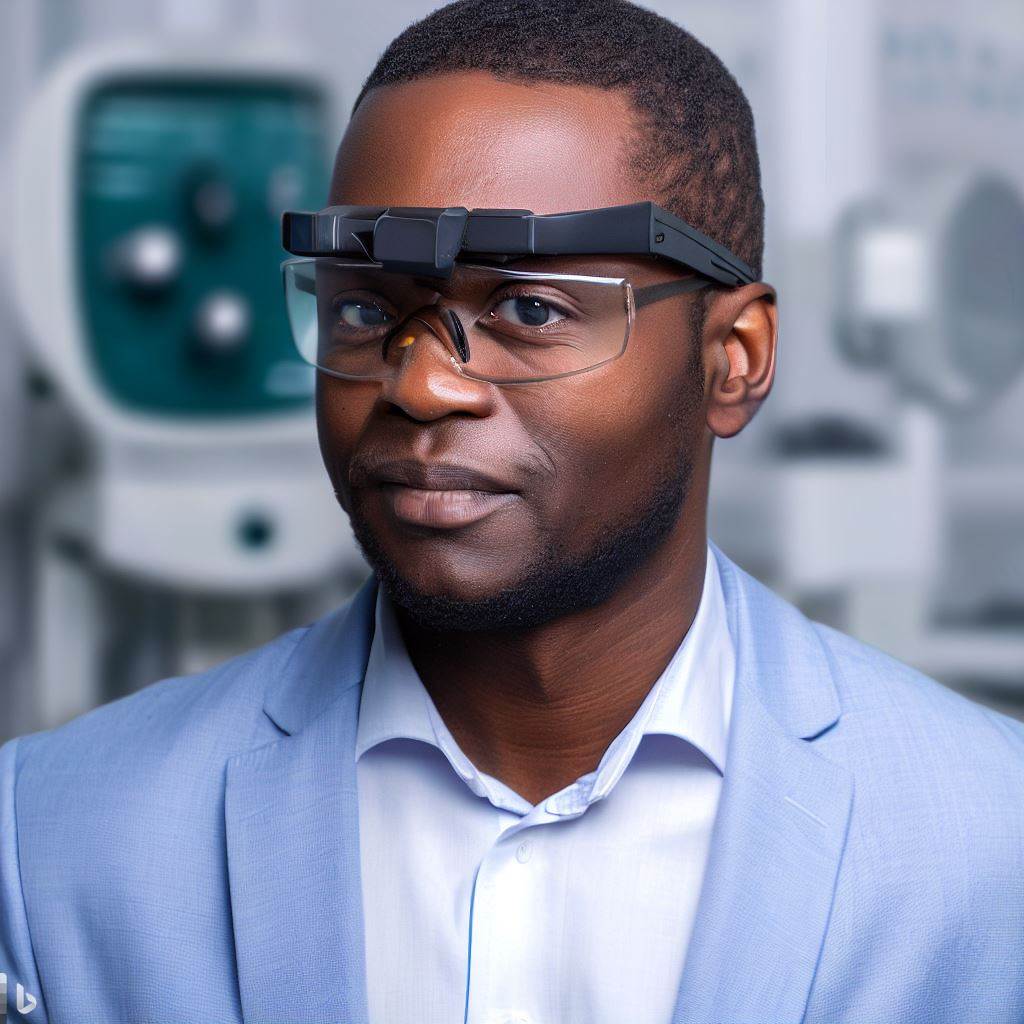Introduction
In recent years, technology has revolutionized various industries, including healthcare. Optometry, a branch of healthcare focused on eye care, has also witnessed significant advancements due to technological innovations.
Nigeria, being a developing country with a population of over 200 million people, has not been left out of this revolution. The impact of technology on optometry practice in Nigeria cannot be underestimated.
With the introduction of modern tools, optometrists are now able to provide more accurate and efficient eye care services to patients. This has greatly improved the quality of eye care in the country.
Discussing the impact of technology on optometry practice in Nigeria is essential for several reasons. Firstly, it allows optometrists to stay updated with the latest advancements and trends in the field.
By understanding how technology is transforming optometry practice, they can provide better care to their patients and remain competitive in the industry.
Secondly, discussing the impact of technology on optometry practice in Nigeria helps raise awareness among stakeholders and policymakers about the importance of investing in technological infrastructure.
This can lead to the development of better healthcare facilities and improved access to eye care services across the country.
Essentially, technology has had a profound impact on optometry practice in Nigeria. Understanding and discussing this impact is crucial for the growth and development of the field.
By embracing technological advancements, optometrists can enhance patient care and contribute to the overall improvement of eye health in Nigeria.
Technological advancements in optometry practice
Overview of technological advancements in optometry globally
Technological advancements have revolutionized the field of optometry globally. New digital devices and tools have improved the accuracy and efficiency of optometric examinations.
Advancements in computer-based systems and imaging technology have enhanced diagnosis and treatment. Integration of technology has also led to improved patient communication and data management.
Specific advancements in optometry practice in Nigeria
- Digital retinal imaging aids early ocular disease detection and sharing among professionals.
- Optical coherence tomography enhances diagnoses, especially for macular degeneration.
- Automated refraction systems ensure accurate prescriptions for eyewear.
- Telemedicine extends care to remote areas, allowing consultations and collaboration worldwide.
Advancements elevate eye care
- Retinal imaging and OCT improve disease monitoring.
- Automated refraction ensures precise prescriptions.
- Telemedicine expands remote access and global collaboration.
Nigeria’s optometry future shines bright with efficient, accurate, and accessible care.
Read: Continuing Education for Phlebotomists in Nigeria
Improved diagnosis and treatment
Benefits of digital retinal imaging in diagnosing eye conditions
Digital retinal imaging allows for a closer examination of the retina, providing healthcare professionals with a detailed view of the eye’s structures. This technology allows for the early detection of eye conditions such as diabetic retinopathy, macular degeneration, and glaucoma.
By capturing high-resolution images of the retina, healthcare professionals can accurately diagnose and monitor these conditions.
Accuracy and efficiency of optical coherence tomography
Optical coherence tomography (OCT) is a non-invasive imaging technique that produces cross-sectional images of the retina. It allows for the early detection and monitoring of glaucoma, as it provides detailed information about the optic nerve and retinal nerve fiber layer.
OCT also helps assess the severity of macular degeneration by measuring the thickness of the macula and detecting any abnormalities.
Enhanced precision in prescriptions using automated refraction systems
Automated refraction systems use advanced technology to measure a patient’s refractive error more accurately. These systems eliminate human error and subjectivity, resulting in more precise prescriptions for eyeglasses or contact lenses.
Patients can expect improved visual comfort and clarity with the use of these automated systems, which can also save time during eye exams.
Accessibility and convenience through telemedicine
Telemedicine allows patients in remote areas to receive eye care services without traveling long distances. Through telemedicine, patients can consult with optometrists via video calls, receive diagnosis, and discuss treatment options.
This technology improves accessibility to eye care, especially for those with limited mobility or living in underserved communities.
The impact of technology on optometry practice in Nigeria has resulted in improved diagnosis and treatment of eye conditions.
Digital retinal imaging, optical coherence tomography, automated refraction systems, and telemedicine have all contributed to better patient care. These advancements have allowed for early detection and monitoring of conditions such as glaucoma and macular degeneration.
They have also enhanced the precision of prescriptions, leading to improved visual comfort for patients. Through telemedicine, eye care services are more accessible and convenient, benefiting individuals in remote or underserved areas.
Generally, technology has revolutionized the field of optometry, ensuring better eye health outcomes for the population of Nigeria.
Read: Day in the Life: What It’s Like Being an Optometrist in Nigeria

Challenges in adopting new technologies
- Financial considerations for implementing advanced technology: Implementing advanced technology in optometry practices in Nigeria can come with significant financial challenges. The cost of acquiring and maintaining state-of-the-art equipment can be exorbitant.
- Training and education for optometrists and technicians: Optometrists and technicians need to receive proper training and education to effectively utilize new technologies. This requires time and financial investment in specialized training programs.
- Lack of awareness and resistance to change: There is a lack of awareness among optometrists and technicians regarding the benefits of adopting new technologies. This leads to resistance to change and a preference for traditional methods.
Read: Challenges and Solutions in Nigeria’s Social Work Practice
You Might Also Like: Demand for Physician Assistants in Nigeria’s Healthcare System
Overcoming the challenges
Optometry practices in Nigeria can overcome the challenges posed by technology through various strategies:
- Development of partnerships with technology providers: Optometrists should collaborate with technology providers to develop customized solutions that address specific challenges in their practice. This can include implementing electronic health records, telemedicine platforms, and diagnostic tools.
- Government support and incentives: The Nigerian government can play a crucial role in supporting optometry practices by providing financial incentives and creating favorable policies. This can help optometrists invest in technology and upgrade their practices.
- Continuous professional development and training opportunities: Optometrists should actively seek continuous professional development and training opportunities related to technology. This can help them stay updated with the latest advancements and effectively integrate technology into their practice.
- Advocacy and awareness campaigns: Optometry associations and professional bodies should engage in advocacy and awareness campaigns to promote the benefits of technology in optometry practice. This can help dispel misconceptions and encourage the adoption of technology.
By implementing these strategies, optometry practices in Nigeria can overcome the challenges associated with technology and leverage its full potential to improve patient care and outcomes.
Read: Common Challenges Faced by Optometrists in Nigeria
Future prospects and recommendations
To harness the full potential of technology in optometry practice in Nigeria, several recommendations can be made.
The potential impact of artificial intelligence and machine learning
Firstly, optometrists should embrace and explore the potential impact of artificial intelligence and machine learning.
Artificial intelligence and machine learning can revolutionize optometry practice in Nigeria. These technologies can enhance diagnostic accuracy and treatment planning for eye conditions.
Through AI, optometrists can analyze large amounts of patient data to make personalized recommendations. Machine learning algorithms can assist in early detection of eye diseases and improve preventive interventions.
Furthermore, AI-powered virtual assistants can provide 24/7 support to patients, delivering immediate information and guidance.
By leveraging these technologies, they can enhance diagnosis, treatment, and personalized patient care. Incorporating AI-powered virtual assistants can also ensure continuous patient support and education.
Importance of keeping up with technological advancements
Secondly, it is crucial for optometrists to stay updated with technological advancements.
Continuous professional development programs should be designed to provide training on the latest tools, techniques, and software in optometry. This will allow practitioners to deliver better and more efficient eye care services.
Optometrists in Nigeria must stay updated with emerging technologies to provide quality eye care. Continuous professional development programs should include training on the latest tools and techniques.
Adopting new technologies can lead to increased patient satisfaction and loyalty. Hence, efficient usage of technology can streamline clinic operations and reduce human error.
Also, optometry practices that embrace innovation are more likely to thrive in a competitive healthcare landscape.
Collaboration with other healthcare professionals for better patient outcomes
Collaboration with other healthcare professionals is essential for better patient outcomes.
Interdisciplinary collaboration can greatly benefit the optometry profession in Nigeria. Working with ophthalmologists, pharmacists, and other healthcare experts can facilitate holistic patient care.
Additionally, shared knowledge and expertise can result in earlier detection and management of complex eye conditions.
Collaboration can also help optimize treatment plans and improve overall healthcare outcomes. Moreover, creating multidisciplinary teams can expand access to high-quality eye care services in underserved areas.
By working together with ophthalmologists, pharmacists, and other experts, optometrists can provide comprehensive and holistic care. Through shared knowledge and expertise, complex eye conditions can be managed more effectively, leading to improved healthcare outcomes.
In essence, the impact of technology on optometry practice in Nigeria is significant and holds great promise for the future.
Embracing artificial intelligence, keeping up with technological advancements, and fostering collaboration with other healthcare professionals can ensure that optometrists provide the best possible care to their patients.
By staying proactive and adaptable, optometry practices in Nigeria can thrive in an evolving healthcare landscape.
Read: Interview Tips for Aspiring Phlebotomists in Nigeria
Conclusion
The impact of technology on optometry practice in Nigeria has been transformative, leading to significant improvements in patient care and outcomes.
With the introduction of modern tools such as digital retinal imaging, optical coherence tomography, automated refraction systems, and telemedicine, optometrists can now provide more accurate, efficient, and accessible eye care services.
While there are challenges in adopting new technologies, optometrists are encouraged to overcome these obstacles.
They can achieve this by seeking partnerships with technology providers, advocating for government support and incentives, investing in continuous professional development, and raising awareness about the benefits of technology.
Looking to the future, embracing artificial intelligence and machine learning, staying updated with technological advancements, and fostering collaboration with other healthcare professionals are vital steps for further advancements in optometry practice.
By leveraging technology and embracing innovation, optometrists in Nigeria can lead the way in delivering world-class eye care services, ultimately improving the eye health and well-being of the nation’s population.




